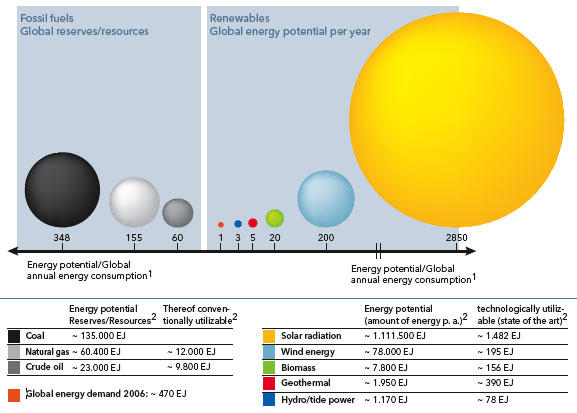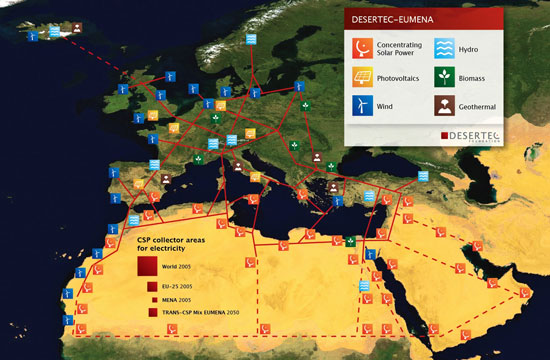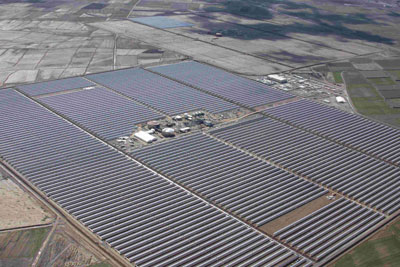| Posted: Jul 13, 2009 | |
Desertec - a nanotechnology-enabled bold vision for an energy revolution |
|
| (Nanowerk Spotlight) In our Spotlight from April 2008 we asked the question "why don't we have a nanotechnology Apollo Program for clean energy?". Although governments and industry are pouring billions into nanosciences and nanotechnologies, the results so far have been gazillions of research papers and a few hundred (mostly consumer) products and applications that would go unnoticed (and most of them are) if not for their perceived "nano" hype or scare factor, depending where you are coming from. Our concluding paragraphs from this Spotlight were: | |
| "There is no doubt that nanotechnologies could provide the solutions to our energy problems, not today, and not tomorrow, but with a massive, coordinated and international effort a 10-20 year timeframe seems not unrealistic. Today's various national nanotechnology programs fund their vast hodgepodge of research initiatives more from a viewpoint of basic research (or, in the case of the U.S., military wish lists) than with a focus on commercial implementation – in the process scattering funding resources by trying to cover each and every potential application. | |
| "Instead, the leading dozen or so nanotechnology nations should get together and commit to a concerted and massively funded 10-year program to develop commercially viable, clean energy solutions based on nanotechnology. Rather than have bureaucratic government departments oversee the effort there should be a new agency – much like the can-do organization that NASA was in the 1960s – to drive this effort forward in close cooperation with academia and industry." | |
| Although future energy supply will be a mix of all available sources, given the sheer scale of its potential, the single most promising area for an energy revolution is solar energy. The question is how to tap this potential on a large scale. One possible answer is project Desertec. | |

|
|
| 1 EJ = 1 exajoule or 1018 joules or ∼163 million barrels of oil. Global potential of available renewables and fossil fuels 1: Data referring to global energy consumption of 390 EJ in 1997, data from M. Fischedick, O. Langniß, J. Nitsch: „Nach dem Ausstieg – Zukunftskurs Erneuerbare Energien“, S. Hirzel Verlag, 2000 2: Data source: German Federal Institute for Geosciences and Natural Resources. (Graphic: Application of Nanotechnologies in the Energy Sector) | |
| A solar energy revolution in the making | |
| As it turns out, a very ambitious idea that has been kicked around for the past couple of years – and whose scope definitely is on par with the Apollo Program – has gained a lot of momentum over the past few months. The vision that, if realized, would be a true energy revolution, is called Desertec and would amount to the biggest solar energy project of all times. | |
| Today, July 13, a group of 20 large industrial companies, banks and insurance companies are meeting in Munich to kick of a project that, if realized, will cost 400-500 billion euros ($550-700 bn) and deliver its first energy in about 10 years. The basic idea is to install a huge network of concentrating solar-thermal power plants in the Sahara desert and build a network of High-Voltage Direct Current (HVDC) transmission lines to carry the electricity to Europe. The project founders will devote the next three years to sort out the details of this gigantic scheme. | |
| The Desertec concept describes the perspective of a sustainable supply of electricity for Europe, the Middle East and North Africa up to the year 2050. By then, it could satisfy as much as 15 percent of the European Union's power needs. It shows that a transition to competitive, secure and compatible supply is possible using renewable energy sources and efficiency gains, and fossil fuels as backup for balancing power. Also, the technology exists today – it's the scale of the vision that's revolutionary. | |

|
|
| Sketch of possible infrastructure for a sustainable supply of power to Europe, the Middle East and North Africa (EU-MENA). For illustration: the red squares indicate the space needed for solar collectors to produce the present power for the world (18.000 TWh/y, 300x300 km2), for Europe (EU 3.200 TWh/y, 125x125 km2) and for Germany or MENA (Middle East and North Africa, about 600 TWh/y, 55x55 km2). The square labeled "TRANS-CSP Mix EUMENA 2050" indicates the space needed for solar collectors to supply the needs for seawater desalination and about two-thirds of the electricity consumption in MENA in the year 2050 and about one-fifth of the European electricity consumption by Concentrating Solar Thermal Power Plants (2,940 TWh/y in total). | |
| According to Desertec, in order to meet today's global power demand of 18,000 TWh/year, it would suffice to equip about three thousandths of the world‘s deserts (about 90,000 square kilometers) with solar collectors of solar thermal power plants. About 20 square meters of desert would be enough to meet the individual power demand of one human being day and night – all this absolutely CO2 free. | |
| Concentrating solar-thermal power plants | |
| There are basically three components required to make a Concentrating Solar-Thermal Power (CSP) Plant work in a concept like Desertec's: The energy harvesting collectors (the "receivers"); large heat accumulators that act as energy surplus storage; and high-voltage transmission lines to carry the electricity to remote destinations. | |
| CSP plants are are basically steam-generating power stations that produce electricity from heat – only that the energy is supplied by the sun and not oil, gas or coal. The solar radiation is collected by means of large reflector surfaces such as parabolic mirrors. Through the concentrated radiation, the heat transfer medium – an oil (for instance vegetable oil) that flows through the receiver – is heated to up to 500°C. The hot heat transfer oil is then pumped into the main generating unit. The heat produces steam that in turn drives the plant's turbines to generate electricity. | |
| This technology already works on a large scale. On July 1, 2009 the solar-thermal power station Andasol 1, located in the Spanish province of Granada in Andalusia, was officially inaugurated. This 50 megawatt plant is the largest solar power plant in the world, providing climate friendly power to 200,000 people. Two more 50 MW plants, Andasol 2 and 3, will go online this year and in 2011. In the Mojave desert in California, nine CSP plants have been operating successfully for up to 20 years. | |

|
|
| Andasol solar power plant – 500 000 square meters of mirror surface catch sunlight. (image: Solar Millennium AG) | |
| The nanotechnology component | |
| Nanotechnology is essential in fabricating the receivers, the key components of a CSP. The quality of the receiver determines the efficiency of the solar power plant; which in turn determines its cost/benefit performance when compared to other energy sources. Nanocoatings on the receivers' surface improve their thermal capture and thermal transfer properties as well as provide corrosion resistance. A particular challenge and potential cost factor is the long-term stability of the receivers. To make CSP plants economically viable, they need to withstand more than 20 years of intense solar radiation and climate impact. | |
| Examples of this technology are nanocoatings from Schott Solar, which supplied receivers for the Andasol plant and has been developing this technology together with the Fraunhofer Institute for Solar Energy Systems ISE and the Technical University Clausthal-Zellerfeld; and nCoat, which is collaborating with Sunvention USA, Inc. and BSR Solar Technologies GmbH to use nCoat nanotechnology coatings for a demonstration CSP plant in Indiana. | |
| In contrast to CSP plants like Andasol, photovoltaic (PV) cells convert sunlight directly into electricity. Photovoltaics is used in large-scale solar plants as well but this is the technology that brings solar energy supply to individual households by putting solar panels on the roof. Ultimately, through nano-enabled thin film technology, solar energy harvesting surfaces will be integrated into many products and structures. | |
| The major problem of photovoltaic solar energy – its relative inefficiency – still needs to be overcome to make the cost of electricity produced by solar cells equal or less than electricity produced by nuclear or fossil fuels and to allow solar energy to become a major energy source independent from government subsidies (although the established carbon based energy sources still receive plenty of subsidies even today). | |
| Until now, solar cells that convert sunlight to electric power have been dominated by solid state junction devices, often made of monocrystalline or multicrystalline silicon wafers. Efforts are being made in laboratories worldwide to design ordered assemblies of semiconductor nanostructures, metal nanoparticles and carbon nanotubes for constructing next generation solar energy conversion devices (read for instance: "The impact of carbon nanotubes on the use of solar energy " or "Catching a rainbow - quantum dot nanotechnology brightens the prospects for solar energy"). These offer the prospects of cheaper materials, higher efficiency and flexible features. It is expected that a variety of PV devices made from thin-layer solar cells (of silicon or other material systems like copper/indium/selenium), dye solar cells, or polymer solar cells will bring the breakthrough. | |
| There is a tremendous amount of research effort devoted worldwide to develop not only solar energy but other clean and renewable energy sources as well. But given the scope and speed of climate change that we are in for, it is the realization of big and bold visions like Desertec that are required to provide a way out. | |
| Watch a video of a news report about Desertec: | |
 By
Michael
Berger
– Michael is author of three books by the Royal Society of Chemistry:
Nano-Society: Pushing the Boundaries of Technology,
Nanotechnology: The Future is Tiny, and
Nanoengineering: The Skills and Tools Making Technology Invisible
Copyright ©
Nanowerk LLC
By
Michael
Berger
– Michael is author of three books by the Royal Society of Chemistry:
Nano-Society: Pushing the Boundaries of Technology,
Nanotechnology: The Future is Tiny, and
Nanoengineering: The Skills and Tools Making Technology Invisible
Copyright ©
Nanowerk LLC
|
|
|
Become a Spotlight guest author! Join our large and growing group of guest contributors. Have you just published a scientific paper or have other exciting developments to share with the nanotechnology community? Here is how to publish on nanowerk.com. |
|
